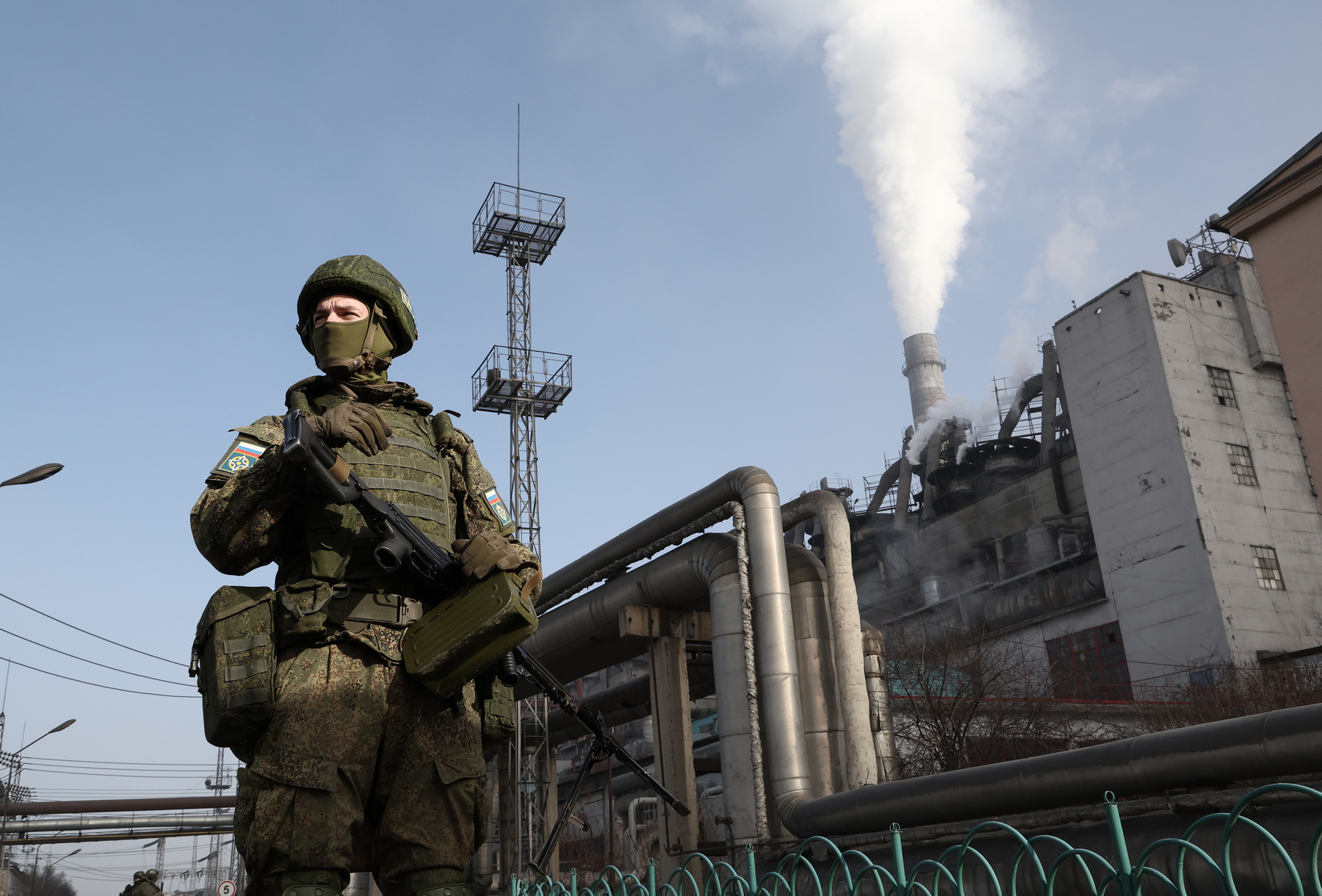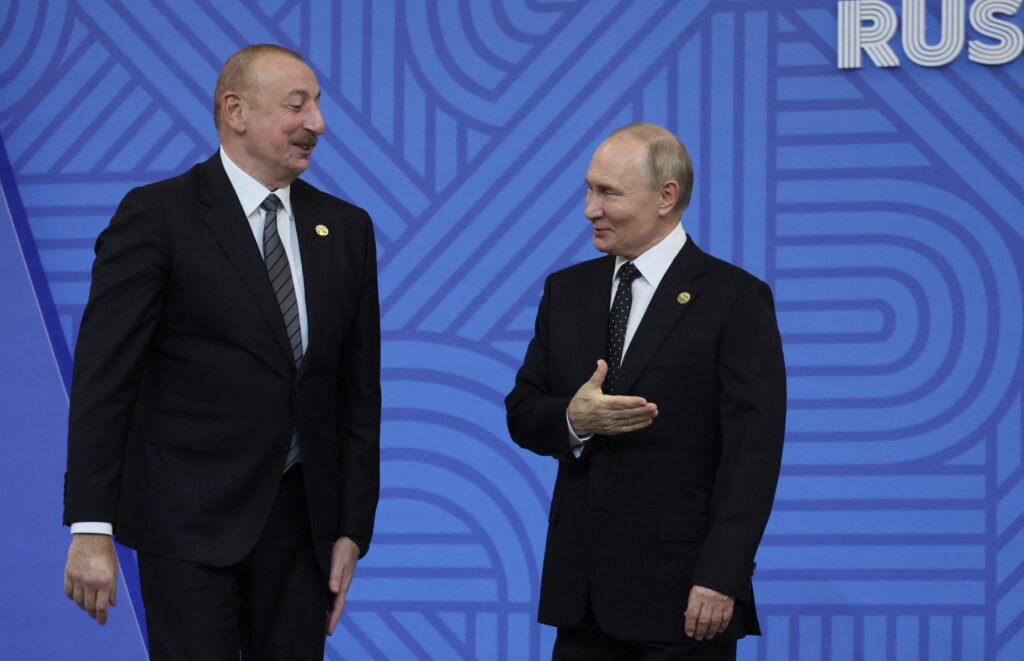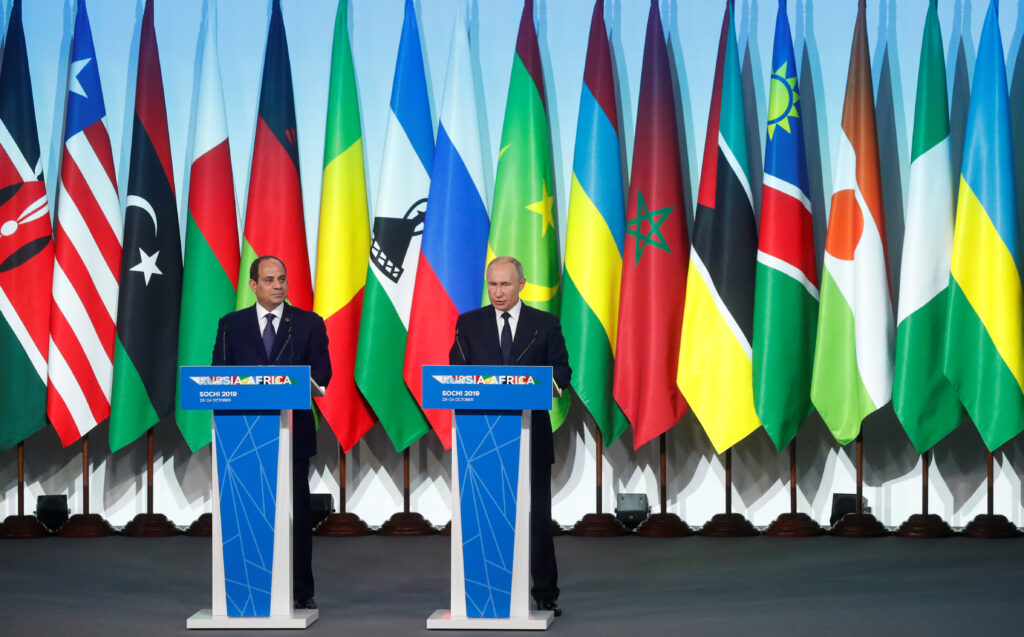Much remains unknown in the ongoing crisis in Kazakhstan. But what is already clear is that it is the largest political rupture this Central Asian nation has seen since the collapse of the Soviet Union, and there are several questions in need of investigating. What has been the extent, for instance, of elite involvement in protest violence? Or who is prevailing in the apparent struggle between ‘leader of the nation’ Nursultan Nazarbayev and the incumbent President Kassym-Jomart Tokayev, Nazarbayev’s handpicked successor?
Even for political insiders, those answers are proving elusive even as the situation unfolds. For Russia, however, the Kazakh crisis has already recast its bilateral, regional and international outlook. Even as the shock of the unrest reverberates — and aftershocks likely loom — the immediate impact of Russia’s intervention is significant and noticeable.
New life for the CSTO
Taken under the guise of the Collective Security Treaty Organization (CSTO), Russian troops arrived in Almaty on 6 January, responding to an overnight call by Tokayev. The intervention took place almost immediately after Tokayev requested it, which opens the possibility that the CSTO, heretofore seen as a largely toothless Moscow-led alliance, may become a genuine vector for Russian influence among its wider membership. The CSTO has never before approved a request for intervention — including most recently Armenia’s 2020 plea that it respond to the conflict with Azerbaijan over Nagorno-Karabakh.
Armenian Prime Minister Nikol Pashinyan has quickly embraced the intervention, perhaps seeing the CSTO’s new lease of life as a potential future buffer for his beleaguered nation in its conflict against Azerbaijan. Then again, his endorsement is not without irony: Pashinyan himself came to power on the back of a street protest movement against a Russia-linked kleptocratic elite not too dissimilar from Nazarbayev’s. Still, Pashinyan may have reason to hope that a more proactive CSTO is more likely in the South Caucasus now than in 2020. Back in 2020, the CSTO had an excuse to stand aside. Nagorno-Karabakh is de jure recognized as part of Azerbaijan and thus not within the CSTO guarantee for Armenia. On top of that, Russia’s military was not well placed for immediate intervention. But since the December 2020 peace agreement that the Kremlin mediated, there have been sporadic clashes along the international border and sometimes beyond it. Russia has now built defence positions close to the de jure border in Armenia, and its response to Kazakhstan’s crisis could be a signal to Armenians that the imbalance of power between Russia and its neighbours means the Kremlin can continue to interpret the CSTO rules as it pleases.
Acting because it was convenient in Kazakhstan does not, however, by default increase the chances Moscow will respond when it may be inconvenient. But it may increase its already well-established propensity for affecting internal regime formation in the former Soviet Union.
Diversion from Ukraine
The crisis in Kazakhstan escalated so quickly that it is hard to imagine Russian generals had Almaty on their minds as they celebrated New Year. Instead, Russian troops — including those from the Central Military District closest to Kazakhstan — had amassed near the Ukrainian border. Talks were already afoot with the Biden Administration, sparked by the fear of a renewed and expanded Russian invasion of Ukraine. Epitomising the sense of how far the scene changed was how British Foreign Minister Liz Truss was incongruously speaking of deterring Russian intervention in Ukraine in a statement to the House of Commons — just as the first videos of Russian troops arriving in Kazakhstan came out.
The Kremlin, meanwhile, will see its action in Kazakhstan as an example of how it can act as a guarantor of regional stability in Central Asia. The idea of street protests shaking the foundations of not only the Nazarbayev regime but the system which it has built up were simply too much of a threat for the Kremlin to allow them to continue without response, in particular after their violent escalation. Kazakhstan may not have the same socio-cultural cache as a ‘fraternal Slavic nation’ like Ukraine. Yet its elite is far too closely interwoven with Russia’s own — as exemplified by Nazarbayev’s son-in-law’s 11+ years on Gazprom’s board of directors. It is the only other meaningfully-sized economy in the Eurasian Union. Tokayev’s invitation may likely be driven by internal issues that remain as of yet unclear — but it does appear clear that he did not feel able to trust his own security series — but the immediacy with which he could summon Moscow is notable.
Broadly, Kazakhstan’s crisis comes at a key moment for US-Russian and broader Russian-Western relations. Misunderstandings in Central Asia would raise the prospect the high-stakes talks over Ukraine will go awry.
The popular idea in Western analysis of Russia that President Vladimir Putin is actively attempting to rebuild some kind of imperial space does not preclude that Putin and those around him genuinely believe an intervention in Kazakhstan is a force for good. If there is any truth to the swirling rumors about elite infighting, organized crime, and even elements of the security services fomenting the violence, then it frankly will have created a sincere fear in the Kremlin that Kazakhstan was headed to the kind of ‘1990’s scenario’ whose nightmarish nature Putin so often invokes.
The West is unlikely to be able to see such concern as genuine. Russia’s refusal to acknowledge the domestic corruption element and the cheap and lazy lambasting of the street protests by Russian state media as an attempted ‘colour revolution’ will make finding mutual understanding even less likely. Former US Ambassador to Russia Michael McFaul has already compared the Russian intervention in Kazakhstan to the 2008 Russo-Georgian war and the 2014 invasion of Ukraine and unilateral annexation of Crimea. And Secretary of State Anthony Blinken has already expressed Washington’s expectation that Russian troops may not leave Kazakhstan anytime soon. Even if Russian troops do soon leave, as Kazakhstan has hinted, the fact they were there and could return will make it harder for bilateral Russian-US talks to find common ground on a security paradigm for Eurasia.
Central Asian reverberations
The rebirth of the CSTO, seen as effectively irrelevant just months ago, as a body actually capable of taking action, albeit only when Moscow deems it convenient, will have major regional ramifications in other parts of Central Asia.
Kyrgyz President Sadyr Japarov may feel he can now use the CSTO like in Kazakhstan’s case, should he need to stave off unrest in his restive republic — never mind, like with Pashinyan, that he himself came to power on the back of a street revolution that Moscow refused to be drawn into. Tajikistan’s President Emomali Rahmon — the sole international figure still publicly lambasting the Taliban, who rule over far more ethnic Tajiks than he does — may also feel emboldened to step up requests for Russian support.
Since the Kremlin has never stopped seeing itself as the region’s guarantor of security, Russia will not feel the Kazakh crisis sets a precedent that requires it to intervene in any such scenario if not convenient. Yet given the apparent acquiescence to the move thus far, Putin is likely to cite it as precedent when it is convenient. Other countries in the region will have to take this into account if they distance themselves from Moscow as well. Uzbekistan will be happy it avoided the tensions witnessed in Kazakhstan, for which it has to thank late president Islam Karimov’s regular outbursts of ill-will towards Moscow more than any actual strategic decision-making.
China, however, may well see Russia’s vivification of the CSTO as a reminder that its position remains politically junior to Moscow in the region, even as it economically grows much more influential. Beijing may still be accepting of this; it has even tacitly endorsed Moscow’s move — hence Xi Jinping’s reference to the unrest as an attempted ‘color revolution’. Yet China will expect its economic interests to go unaffected, least of all Kazakhstan’s status as its core route for natural gas imports. If Moscow is unable to contain the Kazakh crisis and its markets are at all affected, it may reconsider whether it is wise for Moscow to be a sole guarantor of security in the region.
These trends may still be accentuated by the domestic situation in Kazakhstan. Russia’s intervention came in effective conjunction with Tokayev’s announcement that he is removing his predecessor Nazarbayev from the security council and reshuffling key security agencies. Again, the domestic politics remain unclear — but with Nazarbayev remaining absent from the public stage and the arrest of Nazarbayev loyalist Karim Massimov on 8 January, who had been serving as chair of the National Security Council (KNB) until 5 January, it is impossible to separate the request for Russian intervention from domestic elite infighting.
Rumors abound that Nazarbayev — who remains entirely absent from the public — is either suffering ill health or otherwise disappeared. His daughter Dariga failed to appear in the legislature where she served as a deputy during its 11 and 12 January sittings, ostensibly she is suffering the effects of COVID-19. Kyrgyz media reports Nazarbayev’s brother fled via their country to Dubai.
Moscow will be forced to respond to forthcoming developments Kazakh domestic politics. Thus far, Russia’s intervention and the apparent has served Tokayev effectively its front man by making Tokayev effectively its front man, which would appear to have granted him him the credibility to retain the loyalty of the Kazakh elite. Yet Tokayev’s has spoken of tackling corruption and entrenched elites, even if new government remains very much a creature of the previous system, potentially as a cudgel against any remaining holdouts. Yet any such reform agenda is unlikely to genuinely auspices is unlikely to go beyond political retribution and the identification convenient scapegoats from Nazarbayev’s innermost circle. If Kazakhs remain willing to take to take to the streets, or elite cohesion collapses, Moscow will likely bear the brunt of any subsequent fallout.










